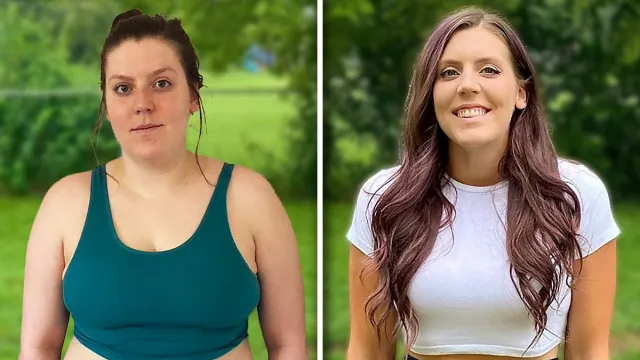She Lost 70 Pounds—Here Are 5 Things She Wishes She Knew First

Starting a weight loss journey can feel overwhelming and intimidating. We often focus on the wrong things and set ourselves up for disappointment. Nikki Madoch (@NikkiGetsFit) knows this all too well. As a self-described "nutrition athlete" with ASM CPT and CNC certifications, Nikki has shared her experience losing an impressive 70 pounds on the Weight Watchers program. Her insights might just be the perspective shift you need to make your own journey more successful and sustainable.
The Right Motivation Makes All the Difference
Most people start losing weight to look better, but that's rarely enough to stick with it long-term. "For so long, I just wanted to look better, have a flat stomach, and look like other people. That was all it was," Nikki admits in her post. She found out that feeling better physically became what truly kept her going, not how she looked, which completely changed her approach and results.
RELATED: 8 High-Protein Foods with Nearly Zero Calories That Melt Fat
Health Benefits Show Up Quickly
The physical improvements from healthier eating can pop up much faster than you might think. "After just one week, I could not believe how much better I felt," Nikki says. She noticed huge differences in her energy and overall well-being after cutting out fast food and focusing on portion control and foods that actually nourished her body.
Feeling Good Trumps Looking Good
Lasting weight loss comes from caring more about how your body feels than how it looks. "What keeps me going is how good I feel when I take care of myself, eat healthy, nourish myself, drink enough water, get enough sleep, and exercise," Nikki points out. While looking better in clothes feels nice, it's the improved quality of life that really drives her to keep making healthy choices.
Body Image Issues Can Actually Increase
Surprisingly, losing weight doesn't magically fix body image issues and might even create new ones. "I didn't know that I would have more body dysmorphia as I lost weight," Nikki confesses. She caught herself becoming more critical and self-conscious about specific body parts during her journey than she had been at her heaviest weight.
RELATED: 20 Foods You Didn't Know Were Ultra-Processed
The Mental Game Gets Tougher
Weight loss demands as much mental strength as physical discipline, especially as you make progress. "It was a whole new mental game that I had to work through," Nikki says about dealing with increased body scrutiny. Learning to shift her focus back to health and strength rather than picking apart her physical imperfections became crucial for her continued success.
Don't Be Afraid to Use All Your Resources
If you're following a structured program, take full advantage of all the flexibility it offers. "I was too scared to use my weeklies," Nikki talks about her initial approach to Weight Watchers points. She later discovered that using all her allotted weekly points actually helped her lose more weight rather than slowing her down.
Strategic Indulgence Works Best
How you use extra calories or points matters more than whether you use them. "What worked best for me was using my weeklies on different snacks that I like—protein bars, nuts, peanut butter spread," Nikki shares. She found that spreading out enjoyable foods throughout the week worked better than saving everything for one big cheat meal.
RELATED: I'm a Nutritionist and These are the Best Banana Recipes For Weight Loss
Variety Prevents Burnout
https://www.instagram.com/p/DHT5nEKvPt8/?utm_source=ig_embed&utm_campaign=loading
Eating the same healthy foods over and over leads to boredom and eventually giving up. "It is very easy to get burned out of things, and it's very important to switch things up," Nikki warns. She learned to keep introducing new recipes, ingredients, and meal ideas to keep her plan interesting and something she could stick with.
Try One New Thing Weekly
Small changes make a big difference in keeping meals from getting boring. "Just trying to add a new recipe each week, just a simple recipe, so that I'm trying something new," Nikki suggests. This approach keeps meals exciting without becoming overwhelming or taking too much time.
The Scale Doesn't Tell the Whole Story
Weight is just one measurement and often a misleading one, especially when building muscle. "Weight and the number on the scale is not everything," Nikki insists. She weighs 190 pounds at 6 feet tall and feels healthier now than when she weighed less but had less muscle.
RELATED: What Happens When You Quit Soda, According to a Nutritionist
Progress Photos Tell a Better Story
Visual proof of body changes can be more motivating than scale numbers. "I'm actually really happy that I did start taking progress pictures from the start," Nikki mentions. These photos helped her see that she looked smaller at a higher weight due to muscle gain, proving that the scale wasn't telling her the full story of her success.
Embrace Multiple Ways to Measure Success
Relying only on weight can lead to frustration, especially during plateaus. "Having different ways to not focus so much on the scale to see your progress is so important," Nikki talks about. She figured out how to judge her progress through how clothes fit, strength gains, and overall wellbeing rather than obsessing over a specific number.
Final Word
Nikki's journey shows that lasting weight loss comes from focusing on health, enjoyment, and sustainable habits rather than just appearance or numbers on a scale. By shifting your perspective on motivation, measurements, and what truly matters, you can create a healthier relationship with food and your body that lasts far beyond reaching your goal weight. And if you enjoyed this article, take advantage of these 15 Quick Ways to Lose Body Fat Percentage in a Week.




